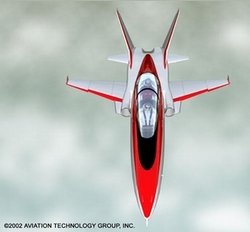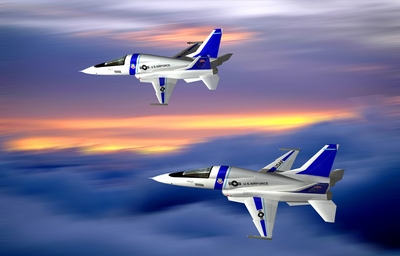Point Interceptor, Executive Jet, Critical Cargo Delivery...
SportPlane?
By ANN Correspondent Allan Lockheed
Friday evening, in south suburban Denver, a remarkable new
aircraft was introduced to several hundred Coloradans: Aviation
Technology Group's Javelin.
It it, simply put, a fast little two-seat jet; and it can do
everything a baby fighter plane would be expected to do.
Since September 11, it may do other things, as well.
 Conceived as "A new class of business travel," the
Javelin, a tandem-seat, twin-engined, .92 Mach-cruising, aluminum
bird, it was originally to have served as a "Viper for the Sky,"
something well-heeled and talented execs could use instead of their
usual gas-guzzlers. After all, most high-end corporate travel
doesn't depend on a large party's going from one place to another.
If the exec is a current rated pilot, he can bring a companion, in
the pressurized Javelin. If he isn't a pilot at all, he can still
get to the meeting, in style (and very little time).
Conceived as "A new class of business travel," the
Javelin, a tandem-seat, twin-engined, .92 Mach-cruising, aluminum
bird, it was originally to have served as a "Viper for the Sky,"
something well-heeled and talented execs could use instead of their
usual gas-guzzlers. After all, most high-end corporate travel
doesn't depend on a large party's going from one place to another.
If the exec is a current rated pilot, he can bring a companion, in
the pressurized Javelin. If he isn't a pilot at all, he can still
get to the meeting, in style (and very little time).
The Javelin, unlike some surplus twinjet trainers, will be easy
on fuel. The new Williams FJ-33s will allow operating costs of, the
company says, about 72 cents a mile, as the 33-degree-swept wings
slice the air, at altitudes over 50,000 feet. Like some
high-performance SportPlanes, though, the Javelin will do a
360-degree roll in under 3 seconds; and it will climb, at 250KIAS,
at 10,000 fpm. After all, its MTOW is just 4600 pounds -- and it
has 3000 pounds of thrust. Empty weight? 2510.
With a range of 1250 nm, ATG President George Bye sees other
uses for the machine. He knows how badly airlines need to keep on
schedule; he understands how critical parts can keep whole
companies' computer systems shut down, stopping production; he
realizes that sometimes the only qualified technician is a thousand
miles from the problem that needs fixing; and he sees the Javelin
as a solution.

Since September 11, he sees a new application: point
interceptor. At roughly 5% of the cost of an F-16, the Javelin
could be stationed in places where the military just can't justify
an entire air operation; carrying minimal weaponry, and without the
need for defensive equipment, Javelins could fill in the holes in
the security net over the country.
As a high-performance, low maintenance, economical trainer,
Bye thinks the Javelin could find plenty of work, both in the
military and civilian roles.
As a SportPlane, it can do just about anything that
much-more-expensive machines can do; and, when compared to, say,
the popular L-39, it can do them for a fraction of the operating
costs -- and the manufacturer is in the USA.
Oh, yes -- the manufacturer: the Javelin, as we mentioned in
these pages a couple months ago, will be built by the
eminently-qualified Luscombe folks in Oklahoma. That operation,
headed by the very same guy who resurrected the Cessna
single-engine manufacturing line, can build Javelins at whatever
rate Mr. Bye can sell them. All-aluminum construction means the
machine will be repairable worldwide; simple construction
(considering the performance) means repairs will be inexpensive. At
102 gph (at .92 Mach), the Javelin, once paid for (initial $26,000
deposits secure a $1.88 million delivery price), won't be a
constant irritation to your accountant.
So, if you always wanted a 'Viper for the Skies,' and you don't
mind being seen in what looks like a tiny F-5 or F/A-18 (do I hear
anyone complaining?), the Javelin might be just the thing to
consider, that you never considered before. The hard points are
available on government contracts only, though...
Skeptical? Talk with the ATG people at Oshkosh; they'll be
there.
 Aero-FAQ: Dave Juwel's Aviation Marketing Stories -- ITBOA BNITBOB
Aero-FAQ: Dave Juwel's Aviation Marketing Stories -- ITBOA BNITBOB Airborne 05.19.25: Kolb v Tornados, Philippine Mars, Blackhawk Antler Theft
Airborne 05.19.25: Kolb v Tornados, Philippine Mars, Blackhawk Antler Theft Klyde Morris (05.19.25)
Klyde Morris (05.19.25) Airborne-NextGen 05.20.25: Drone Regs, Zero-Emission Cargo, Door-Dash Drone
Airborne-NextGen 05.20.25: Drone Regs, Zero-Emission Cargo, Door-Dash Drone Airborne Affordable Flyers 05.22.25: RV-15 Finalizing, OSH NOTAM, Kolb v Tornado
Airborne Affordable Flyers 05.22.25: RV-15 Finalizing, OSH NOTAM, Kolb v Tornado




